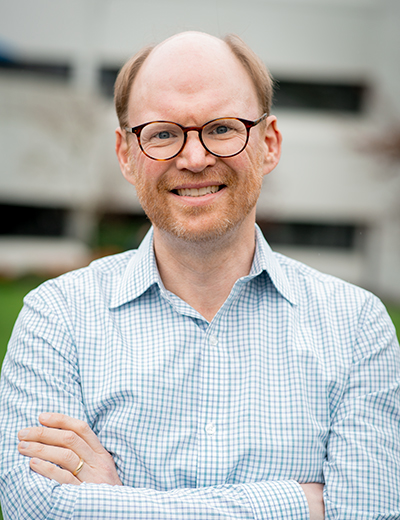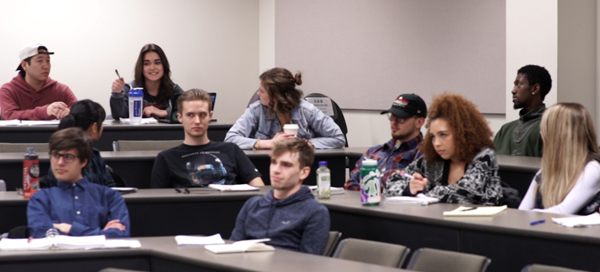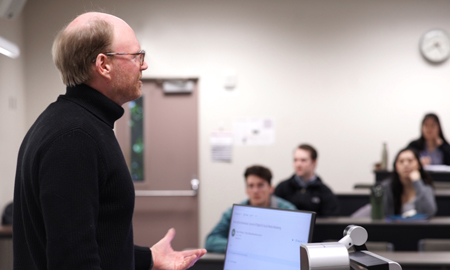Portfolio

Creating Lifelong Learners through Open Educational Practices
Mark G. Staton
Department of Finance and Marketing
When Western hired me in 2012 to teach Digital Marketing, a course on using the internet for marketing purposes, I decided to leverage the internet to optimize the learning outcomes for the students. The first thing I did was peruse job listings for entry level digital marketing jobs. What were the specific skills that our students needed to have to be successful on the job market? Then, to validate my findings, I interviewed alumni who were working in the field and asked them what could separate Western alums from graduates of other schools when competing for the same jobs. One alum I spoke to, Andrew Dumont (who won the 2018 Young Alumnus of the Year), said something that was very impactful. He said, "Today, if you're not searchable, you're not hirable." This advice drove me to make my course as open as possible. Using resources from the internet for teaching and assessment, and having the students work be "universally accessible" allows them to:
"Today, if you're not searchable, you're not hirable." This advice drove me to make my course as open as possible.
- have access to the most up-to-date course content;
- learn how to keep their knowledge fresh; and
- to quote Andrew, "be searchable."

Digital marketing is a field that is constantly changing, which makes the Digital Marketing course a fun, yet challenging course to teach. I have some core philosophies around open educational practices that I have stuck with over the years. These include: no textbook, video chats, blogging, and certifications.
No Textbook
A textbook does not work for this class because, as I have mentioned, the field is constantly changing. For example, many books currently on the market pre-date voice-enabled devices like Google Home or Amazon Alexa, which have dramatically changed strategies regarding search engine optimization. Every quarter, I decide which topics I am going to cover, and then find up-to-date and free articles, blog posts, e-books, podcasts, or videos for the students to review. Needless to say, telling students on the first day of class that they don’t need to buy a textbook usually makes them very happy.
Every quarter, I decide which topics I am going to cover, and then find up-to-date and free articles, blog posts, e-books, podcasts, or videos for the students to review. Needless to say, telling students on the first day of class that they don’t need to buy a textbook usually makes them very happy.
These different assets come from a variety of sources, but often are examples of content marketing, where companies produce high-quality, non-promotional content that assist potential customers with specific questions, and also lead those potential customers to their websites through search engine queries.

Using these resources has multiple benefits. As the students learn what makes good content marketing, many of them will end up using content marketing as one of their digital marketing tools when in the work force, and they start to learn what type of content they should produce to make themselves more "searchable" and "hirable." Also, to reiterate, they're all free.
Video chats
Another thing I do to encourage open educational practices is the use of Google Hangout to do video chats with professionals in the digital marketing field. For example, if we are discussing Paid Search Advertising, I will do a 30 minute video chat with Dallas Contreras, a recent alum who works in Seattle for Bing.

This is beneficial in a couple of ways:
1. It allows the students to hear from someone who is working in the field right now, and has a better sense of changes in the industry than I may have; and
2. It allows the students to hear from someone more like themselves, as opposed to a professor.
Representation is very important to me, so I try to select a diverse group of speakers, hoping that every student sees someone that reminds them of themselves. Additionally, since the speakers usually are alumni of the class, this creates a sense of community among current students and alumni. I’ve had a couple of alumni tell me that a highlight of their career was receiving a call from me asking them to do a video chat with the class. The Hangouts give the students current industry knowledge, and being a Hangout guest encourages alumni to be as well informed about their industry as possible.

Blogging
While I upload a syllabus to Canvas every quarter, which I have attached to this portfolio, I communicate the majority of the assignments through my LinkedIn page.

Every Friday morning, I write a blog post describing the next week’s classes. These blogs have links to content the students must review before class and instructions for the blogs that they will write. Since I post this on my public LinkedIn page, anyone who follows me can comment on the topic of the week. Former students and industry professionals often leave comments emphasizing how important that particular topic is or offering additional resources that students should access to further their understandings.
Student Blogging
The students publish their own twice-weekly blog posts to their LinkedIn pages, which creates an additional “open educational practice.” As with my blog, former students or industry professionals come across their blogs, offer comments, and encouragement, and regularly these online connections result in offers for job interviews and employment. I think this part of the course, in particular, "empowers [the students to] become contributing members to the public marketplace of ideas" (DeRosa and Robinson, 2017). The final blog assignment of the quarter is always entitled "What I can do for you as a digital marketer," which summarizes their learning and becomes an especially powerful tool for attracting attention from potential employers.

Certifications

Assessment isn’t fun—for students or for faculty. What I do to make it seem more valuable is, instead of creating my own examinations, I have students do four different free online certification exams related to topics we cover in class: Google Analytics, Hootsuite Social Media Management, HubSpot Inbound Marketing, and Google Ads. Students are given access to the certifications, which I have vetted both for quality and applicability, and then provided time in class to take the examinations. Upon completion, they send screenshots of their scores to me, which I then add to the grade book. These are generally not easy exams, and there is usually a significant spread in the earned scores. The students are then able to include these on their resumes and LinkedIn profiles, and I have heard from many employers that having these certifications gives students a big advantage when looking for jobs.
I have received a lot of positive feedback from my discipline for using these third-party certifications. In 2016, I published a paper about this in Marketing Education Review (Staton 2016) and as of April 2019, the paper has been cited 15 times.
Teaching Lifelong Learning
As I mentioned at the beginning, digital marketing is constantly changing. I tell the students at the beginning of the quarter that most of the things that I teach them will be out-of-date within a few years, and that if they want to have successful careers, they must be lifelong learners. I teach them about digital marketing resources like the Moz blog with their popular video series, Whiteboard Friday, where industry professionals regularly learn about changes in the industry. We talk about other skills they should pick up, and where they can do it, like Udemy. I also let them know, that I will always be a resource for them, and that I want to share their successes and frustrations with them, and help them in any way that I can. And that, no matter what, they should be #alwayslearning.

References
Staton, M. G. (2016). Improving student job placement and assessment through the use of digital marketing certification programs. Marketing Education Review, 26(1), 20-24.
DeRosa, R. and Robison S. (2017). From OER to Open Pedagogy: Harnessing the Power of Open. In: Jhangiani, R S and Biswas-Diener, R. (eds.) Open: The Philosophy and Practices that are Revolutionizing Education and Science. Pp. 115–124. London: Ubiquity Press. DOI: https://doi.org/10.5334/bbc.i. License: CC-BY 4.0
